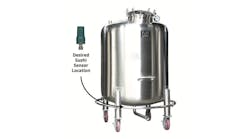A 380,000-ton/yr-capacity ethylene plant at Mitsubishi Chemical Corp.'s Kashima site, Ibaraki, Japan, now is achieving operational savings of about $20,000–$30,000 per day by effectively diagnosing abnormal process conditions and maintaining pressure transmitters using the HART Communication Protocol. Moreover, data provided via HART have led to detection of several device failures that could have caused unscheduled plant shutdowns, each of which would cost a minimum of $3 million.
Because of these results, the HART Communications Foundation, Austin, Texas, has bestowed upon us the 2009 HART Plant of the Year Award. This honor, which is unique in the process automation industry, recognizes ingenuity in the application of HART Communication technology by an end-user.
Our Goal
Five years ago we began installing HART pressure transmitters. The aim was to use HART communication to collect online data from field devices without disturbing the 4–20-mA analog signal to the control system so we could detect abnormal situations in the process and protect field devices from malfunction.
We've since extended our program to other devices, such as vortex and Coriolis flow meters and valve positioners, that offer useful diagnostic functions via HART technology.
Now we have more than 800 HART field devices from a variety of vendors such as Yokogawa, Yamatake, Emerson, Endress+Hauser and Dresser. They are integrated with our Yokogawa Centum CS3000 distributed control system (DCS) as well as our Yokogawa PRM and Fieldmate and Emerson AMS asset management systems through Pepperl+Fuchs multiplexers and via HART-enabled input/output.
This allows us to easily access real-time intelligent data on process variables. (Obtaining such diagnostic data with simple handheld devices is far more difficult because they require a time-consuming manual step-by-step approach.) Because of HART technology, we can diagnose abnormal conditions and track equipment health 24/7.
In addition, HART technology permits trending and analysis of secondary process variables throughout the plant. The insights this provided have allowed engineers to analyze, troubleshoot and resolve a number of operational problems.
For instance, we were able to spot the onset of plugging in an impulse line in a naphtha flow application as well as a plugged manifold valve during startup — allowing us to take proactive steps that reduced maintenance costs and startup time.
We also were able to measure variability in a flow loop, which helped us more rapidly identify the root cause — an area of unstable flow due to inadequate length of straight pipe. Installation of a conditioning orifice plate solved the problem, as HART data verified, and improved plant availability and throughput.
Similarly, advanced HART diagnostics led us to detect an inefficient compressor pump. By catching the problem early, we were able to perform the necessary repairs before it caused damage to the rotor and possibly a plant shutdown.
We estimate that use of HART communications has reduced maintenance costs by 10%.
A Continuing Evolution
We've designated HART as our standard communications protocol and will replace older devices whenever we get the chance. We expect to install 30–40 HART units every scheduled shutdown, and will change other analog devices as needed. We're now also testing Wireless HART devices from Emerson.
In addition, we're developing a partial-stroke valve testing and automatic interlock system on the Yokogawa DCS; we expect to evaluate it during our next scheduled maintenance shutdown. The system should help us reduce maintenance costs even more.
TAKAYUKI AOYAMA is team leader, instrumentation group, maintenance and engineering dept., at the Kashima plant of Mitsubishi Chemical Corp., Ibaraki, Japan. E-mail him at [email protected].

